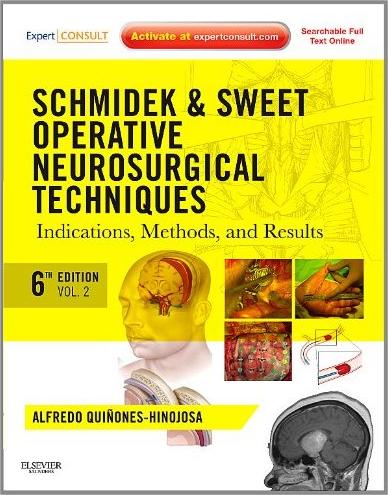Wherever, whenever, or however you need it, unmatched procedural guidance is at your fingertips with the new edition of
Schmidek & Sweet: Operative Neurosurgical Techniques! Completely revised under the auspices of new editor-chief Dr.
Alfredo Quiñones-Hinojosa, this comprehensive medical reference examines indications, operative techniques,
complications, and results for nearly every neurosurgical procedure. Full-color illustrations, 21 new chapters,
internationally-acclaimed contributors, surgical videos, and online access make it a "must have" for today's
practitioner.
- 목차 -
Section I. Introduction
1. Assessing Surgical Innovation
Section II. Trauma to the Scalp, Skull, and Brain
2. Surgical Repair of Major Defects of the Scalp and Skull
3. Perioperative Management of Severe Traumatic Brain Injury in Adults
4. Surgical Management of Severe Closed Head Injury in Adults
5. Decompressive Craniectomy: Physiologic Rationale, Clinical Indications, and Surgical Considerations
6. Surgical Management of Chronic Subdural Hematoma in Adults
7. Penetrating Brain Injuries
8. Surgical Management of Trauma Involving the Skull Base and Paranasal Sinuses
9. Management of Cerebrospinal Fluid Leaks
10. Transnasal Endoscopic Repair of Cranionasal Fistulas
Section III. Orbit
11. Transcranial Approach to Lesions of the Orbit
12. Surgical Management of Intraorbital Tumors
Section IV. Anterior Skull Base
13. Transbasal Approach to Tumors Invading the Skull Base
14. Anterior Midline Approaches to the Skull Base
15. Orbitozygomatic Infratemporal Approach to Parasellar Meningiomas
16. Surgical Management of Olfactory Groove Meningiomas
17. Surgical Management of Tuberculum Sellae and Medial Sphenoid Ridge Meningiomas
18. Sphenoid Ridge Meningiomas
19. Surgical Management of Tumors Involving the Cavernous Sinus
20. Surgical and Endovascular Management of Aneurysms and Fistulas Involving the Cavernous Sinus
21. Craniofacial Resection for Anterior Skull Base Tumors
22. Transtemporal Approaches to the Posterior Cranial Fossa
Section V. Craniopharyngiomas and Pituitary Tumors
23. Stereotactic Radiosurgery for Pituitary Adenomas and Craniopharyngiomas
24. Endocrinologic Approach to the Evaluation and Management of the Patient Undergoing Surgery for a Pituitary Tumor
25. Transsphenoidal Approach to Pituitary Tumors
26. Complications of Transsphenoidal Microsurgery
27. Endoscopic Transsphenoidal Surgery
28. Transcranial Surgery for Pituitary Macroadenomas
29. Surgical Management of Endocrinologically Silent Pituitary Tumors
30. Surgical Management of Growth Hormone-Secreting and Prolactine-Secreting Pituitary Adenomas
31. Repair of the Sella Turcica After Transsphenoidal Surgery
32. Management of Cushing's Disease
33. Craniopharyngiomas: A Summary of Data
34. Surgical Management of Craniopharyngiomas
Section VI. Intracranial and Intraspinal Cysts
35. Surgical Management of Arachnoid, Suprasellar, and Rathke's Cleft Cysts
36. Intraspinal Cerebrosypinal Fluid Cysts
Section VII. Management of Hydrocephalus
37. Cerebrospinal Fluid Shunting and Management of Pediatric Hydrocephalus
38. Surgical Management of Adult Hydrocephalus
Section VIII. New Technologies in Neurosurgery
39. Neuronavigation in Neuroendoscopic Surgery
40. Gamma Knife Surgery for Cerebral Vascular Malformations, Tumors, and Functional Disorders
41. CT/MRI-Based Computer-Assisted Volumetric Stereotactic Resection of Intracranial Lesions
42. Intraoperative Neurophysiology: A Tool to Prevent and/or Document Intraoperative Injury to the Nervous System
43. Ultrasound in Neurosurgery
Section IX. Brain Tumors
44. Frame-Based Stereotactic Brain Biopsy
45. Surgical Management of Cerebral Metastases
46. Management of Primary Central Nervous System Lymphomas
47. Current Surgical Management of High-Grade Gliomas
48. Surgical Management of Low-Grade Gliomas
49. Surgical Management of Lesions in Eloquent Areas of Brain
50. Surgical Management of Recurrent Gliomas
51. Surgical Management of Convexity, Parasagittal, and Falx Meningiomas
52. Neuroendoscopic Approach to Intraventricular Tumors
53. Approaches to Lateral and Third Ventricular Tumors
54. Transcallosal Approach to Tumors of the Third Ventricle
55. Pineal Region Masses: Clinical Features and Management
56. Alternate Surgical Approaches to Pineal Region Neoplasms
57. Supracerebellar Approach for Pineal Region Neoplasms
Section X. Brain Stem Tumors
58. Surgical Management of Brain Stem, Thalamic, and Hypothalamic Tumors
Section XI. Posterior Fossa Tumors
59. Surgical Management of Cerebellar Hemorrhage and Cerebellar Infarction
60. Surgical Management of Cerebellar Astrocytomas in Adults
61. Surgical Management of Tumors of the Fourth Ventricle
62. Radiosurgery of Vestibular Schwannomas
63. Suboccipital Transmeatal Approach to Vestibular Schwannoma
64. Translabyrinthine Approaches to Vestibular Schwannomas
65. Vestibular Nerve Section in the Management of Intractable Vertigo
66. Surgical Management of Lesions of the Clivus
67. Surgical Treatment of Neurofibromatosis
68. Posterior Fossa Meningiomas
69. Petroclival Meningiomas
70. Surgical Management of Glomus Jugulare Tumors
71. Surgical Management of Nonglomus Tumors of the Jugular Foramen
Section XII. Extracranial Vascular Disease
72. Surgical Management of Extracranial Carotid Artery Disease
73. Management of Dissections of the Carotid and Vertebral Arteries
74. Surgical Management of Intracerebral Hemorrhage
75. Surgical Management of Moyamoya Disease in Adults
Section XIII. Management of Intracranial Aneurysms
76. Management of Unruptured Cerebral Aneurysms
77. Surgical Management of Paraclinoid Aneurysms
78. Surgical Management of Posterior Communicating, Anterior Choroidal, and Carotid Bifurcation Aneurysms
79. Distal Anterior Cerebral Artery Aneurysms
80. Microsurgical Management of Anterior Communicating Artery Aneurysms
81. Surgical Management of Aneurysms of the Middle Cerebral Artery
82. Intraoperative Endovascular Techniques in the Management of Intracranial Aneurysms
83. Surgical Management of Terminal Basilar Artery and Posterior Cerebral Artery Aneurysms
84. Surgical Management of Midbasilar and Lower Basilar Aneurysms
85. Surgical Management of Aneurysms of the Vertebral and Posterior Inferior Cerebellar Artery Complex
86. Diagnosis and Management of Traumatic Intracranial Aneurysms
87. Surgical Management of Intracranial Aneurysms Caused by Infection
Section XIV. Management of Intracranial Malformations
88. Surgical Management of Cerebral Arteriovenous Malformations
89. Surgical Management of Arteriovenous Malformations of the Scalp
90. Surgical Management of Cranial Dural Arteriovenous Fistulas
91. Surgical Management of Cavernous Malformations of the Nervous System
92. Surgical Management of the Brain Stem Vascular Malformations
93. Surgical Management of Spinal Cord Tumors and Arteriovenous Malformations
Section XV. Surgical Management of Epilepsy
94. Diagnostic Techniques in Surgical Management of Epilepsy: Strip Electrodes, Grids, and Depth Electrodes
95. Treatment of Intractable Epilepsy by Electrical Stimulation of the Vagus Nerve
96. Temporal Lobe Operations for Drug-Resistant Epilepsy
97. Multilobar Resections in Epilepsy Surgery
98. Multiple Subpial


